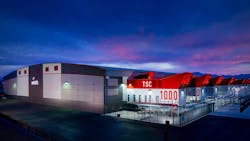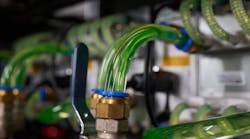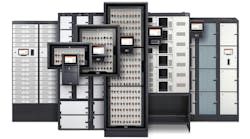Schneider Electric's $2.3 Billion in AI Power and Cooling Deals Sends Message to Data Center Sector
Key Highlights
- Schneider Electric's $2.3 billion in U.S. data center contracts reflect a focus on multi-year supply capacity agreements, ensuring long-term supply of power and cooling systems for AI infrastructure.
- These agreements signal industry confidence in durable AI demand, pre-allocating resources similar to chip supply chains, and raising the bar for vendors to offer integrated 'chip-to-grid' solutions.
- Switch's partnership with Schneider positions the company at the forefront of exascale AI campuses, showcasing high-density, modular cooling and power solutions tailored for future AI workloads.
- Digital Realty's agreement with Schneider secures critical power gear for its expansive AI-focused data centers, standardizing equipment and reducing deployment timelines amid supply constraints.
- The convergence of power and cooling into strategic platforms indicates a shift where these resources are now key, constrained assets, integral to AI data center planning and operations.
When Schneider Electric emerged from its 2025 North American Innovation Summit in Las Vegas last week with nearly $2.3 billion in fresh U.S. data center commitments, it didn’t just notch a big sales win. It arguably put a stake in the ground about who controls the AI power-and-cooling stack over the rest of this decade.
Within a single news cycle, Schneider announced:
- A $1.9 billion multi-year Supply Capacity Agreement (SCA) with Switch, covering prefabricated power modules and what the partners describe as the largest data center cooling project in North America, including the first U.S. deployment of Schneider’s Uniflair chillers.
- A $373 million SCA with Digital Realty, guaranteeing production capacity for UPS systems, low-voltage switchgear, and prefabricated power skids for U.S. builds in 2025–2026.
Together, the deals total about $2.27 billion in U.S. data center infrastructure, a number Schneider confirmed in background with multiple outlets and which Reuters highlighted as a bellwether for AI-driven demand.
For the AI data center ecosystem, these contracts function like early-stage fuel supply deals for the power and cooling systems that underpin the “AI factory.”
Supply Capacity Agreements: Locking in the AI Supply Chain
Significantly, both deals are structured as supply capacity agreements, not traditional one-off equipment purchase orders.
Under the SCA model, Schneider is committing dedicated manufacturing lines and inventory to these customers, guaranteeing output of power and cooling systems over a multi-year horizon. In return, Switch and Digital Realty are providing Schneider with forecastable volume and visibility at the scale of gigawatt-class campus build-outs.
A Schneider spokesperson told Reuters that the two contracts are phased across 2025 and 2026, underscoring that this arrangement is about pipeline, as opposed to a one-time backlog spike.
That structure does three important things for the market:
- Signals confidence that AI demand is durable.
You don’t ring-fence billions of dollars of factory output for two customers unless you’re highly confident the AI load curve runs beyond the current GPU cycle. - Pre-allocates power & cooling the way the industry pre-allocated GPUs.
Hyperscalers and neoclouds have already spent two years locking up Nvidia and AMD capacity. These SCAs suggest power trains and thermal systems are joining chips on the list of constrained strategic resources. - Raises the bar for vendors: To play at this level, a supplier has to deliver an integrated “chip-to-grid” stack: racks, power, cooling, controls, monitoring, services. The more of that stack you can credibly own and coordinate, the more likely you are to land SCA-type deals.
In that context, Schneider’s twin announcements look even less like opportunistic sales, and even more like a positioning move in the escalating arms race around AI infrastructure.
Switch: Blueprint AI Campuses for the Schneider Stack
On the Switch side, the $1.9 billion agreement effectively puts Schneider at the heart of Switch’s exascale AI campuses.
Switch today operates or develops five exascale U.S. data center campuses across Las Vegas and Tahoe Reno (NV), Atlanta (GA), Grand Rapids (MI), and Austin (TX), spanning thousands of acres and multi-gigawatt power capacities.
On top of those Prime campuses, Switch is building a new generation of “EVO AI Factories” in Las Vegas and other markets—smaller buildings with much higher rack densities, explicitly “anticipating 100x density jumps” from ~20 kW to as high as 2 MW per rack in future designs and aligning with Nvidia’s DGX and MGX roadmaps.
The new SCA between Schneider and Switch is pitched by both parties as:
- The largest data center cooling project in North America.
- Schneider’s largest cooling services engagement to date.
- The first deployment of Uniflair chillers in the U.S., coupled with prefabricated power modules to accelerate campus build-outs.
For Schneider, that means Switch’s AI factories effectively become blueprint campuses: e.g. live, multi-gigawatt showcases where it can prove out:
- Uniflair and future liquid-ready thermal topologies at extremely high densities.
- Modular power rooms and skids tuned for AI-heavy rack mixes.
- Long-term service models for AI loads that may swing aggressively in time and intensity.
As Switch deepens relationships with partners like CoreWeave, Oxide, and Oklo on the compute and power side, the Schneider deal makes sure that Schneider’s kit is also in the walls and in the chiller yards of some of the most heavily watched AI campuses in North America.
Digital Realty: A Channel Into the Broader AI Market
If Switch is the vertically integrated AI factory laboratory, Digital Realty is the distribution network. The new $373 million SCA allocates Schneider production capacity for UPS systems, low-voltage switchgear, and prefabricated power skids destined for Digital Realty’s U.S. expansion over 2025–2026.
The agreement includes a dedicated switchgear line intended to help Digital navigate equipment bottlenecks and shorten deployment timelines. Digital’s own disclosures underscore why that matters:
- The REIT says it controls enough land and development rights globally to build ~7.5 GW of computing capacity, with roughly 4.5 GW in the Americas.
- It’s deeply embedded in the AI ecosystem, operating an AI Innovation Lab and partnering with Nvidia on AI Factory research, blueprints, and PlatformDIGITAL architectures.
By locking in Schneider as a primary supplier for core power gear across that roadmap, Digital Realty effectively:
- Standardizes a big chunk of its power train on one vendor’s platforms.
- Gains predictable access to critical gear in a market where switchgear and UPS lead times have stretched.
- Sets a template for regional replication; i.e. once a design is proven in one U.S. metro, Digital can stamp out similar configurations elsewhere with fewer integration unknowns.
For Schneider, this is the other side of its AI strategy. Instead of only co-designing with one vertically integrated player, it now has a front-row seat to the broader AI wave flowing over colocation, spanning from hyperscalers leasing space on PlatformDIGITAL, to enterprises dropping in GPU clusters next to existing hybrid cloud estates.
Power and Cooling Aren’t “Plumbing” Anymore
Zooming our focus out, the Schneider–Switch–Digital Realty trio looks like part of a wider industry grab for AI infrastructure stacks.
Over just a few weeks, we’ve seen:
- Eaton agree to acquire Boyd’s thermal business for $9.5 billion, explicitly to bolt thermal components and liquid-cooling systems onto its power franchise and address AI data center demand.
- Vertiv follow its 2023 acquisition of liquid-cooling specialist CoolTera with a planned $1 billion–$1.25 billion deal for PurgeRite, a services business that handles mechanical flushing, purging, and filtration for liquid cooling systems in data centers.
The throughline is evident. Power and cooling are converging into integrated, strategic platforms, with vendors racing to assemble:
- High-capacity power trains (MV gear, UPS, busway, skids).
- Advanced thermal tech (liquid loops, chillers, CDUs, controls).
- Services and digital twins to operate these systems in an AI-first world.
Viewed through this lens, Schneider’s $2.3 billion in U.S. SCAs can be interpreted as its way of saying: We intend to be one of the few global vendors that can credibly cover that whole stack at AI scale.
For developers and operators, the implication is equally clear. In an environment where AI data centers are soaking up multi-gigawatts of load, power and cooling are no longer just engineering line items. They're now strategic resources that can be constrained and pre-booked, not unlike LNG cargoes or long-term chip capacity.
What It Means for Developers, Utilities, and the Rest of the Market
For data center developers watching these moves from the sidelines, Schneider’s deals offer a few concrete takeaways:
- Multi-year, programmatic procurement is the new norm. Large AI campuses and global colocation platforms are no longer buying power and cooling project-by-project. They are locking in capacity across entire build programs.
- Integrated stacks will win more often than best-of-breed bundles. As campuses push toward 100–150 kW racks and complex mixes of liquid and air, the friction of stitching together many niche vendors increases. Schneider, Vertiv, Eaton and others are betting that “one throat to choke” beats piecemeal integration for many customers.
- Tier-two and regional operators may feel the squeeze. When multi-billion-dollar SCAs carve out dedicated lines for giants, everyone else is competing for what’s left; or else facing longer lead times and higher prices. That may drive more smaller players into aggregated buying groups or strategic alliances with single vendors.
- Utilities and regulators are going to see power vendors at the table more often: If power and cooling suppliers are effectively pre-allocating equipment for multi-GW AI campuses, they may become part of the planning conversation with utilities, not just downstream contractors. We might see more three-way planning between operators, OEMs, and utilities around interconnection, onsite generation, and grid services.
Most of all, the Schneider deals underscore how the AI factory era is tangibly moving from press releases to supply chains. The fight for GPUs may have dominated headlines, but the next front is well underway: a race to secure the electrons, switchgear, busbars, chillers, and CDUs that will keep those GPUs lit and cooled for years to come.
Schneider Electric's Innovation Summit North America 2025 keynote was streamed live on Nov 18, 2025.
At Data Center Frontier, we talk the industry talk and walk the industry walk. In that spirit, DCF Staff members may occasionally use AI tools to assist with content. Elements of this article were created with help from OpenAI's GPT5.
Keep pace with the fast-moving world of data centers and cloud computing by connecting with Data Center Frontier on LinkedIn, following us on X/Twitter and Facebook, as well as on BlueSky, and signing up for our weekly newsletters using the form below.
About the Author
Matt Vincent
A B2B technology journalist and editor with more than two decades of experience, Matt Vincent is Editor in Chief of Data Center Frontier.



